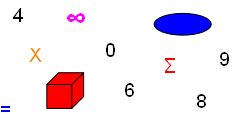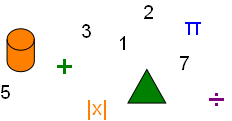



Using Summation Notation


Summation Notation is used to find the sum of some or all terms of a mathematical sequence. In this notation the symbol Σ, a stylized Sigma Greek letter, represents a summation math operation.
n
∑ ai
i = 1
This tells us that we are to sum the first n terms of the sequence (a1 + a2 + a3 + … + an). We also know to begin at the first term because of the index i = 1; i is a variable subscript, the index of summation.
As an example we evaluate:
6
∑ (i − 1) / i 2 = 0/1 + 1/4 + 2/9 + 3/16 + 4/25 + 5/36 = 3451/3600
i = 1
The index of summation can begin at any integer value:
4
∑ k3 = 23 + 33 + 43 = 8 + 27 + 64 = 99
k = 2
How to Sum the First n Terms of an Arithmetic Sequence
Since the first n terms of an Arithmetic Sequence can be written as:
a1, a1 + d, a1 = 2d, a1 + 3d, … , a1 + (n − 1)d
(Where d is the Common Difference)
Or,
a1, a1 + d, a1 + 2d, … , an − 2d, an − d, an
Then the sum of n terms can be found as follows:
sn = a1 + (a1 + d) + (a1 + 2d) + … + (an − 2d) + (an − d) + an
And, writing the sum backward:
sn = an + (an − d) + (an − 2d) + … + (a1 + 2d + (a1 + d) + a1
Adding both sn term by term we get:
2sn = (a1 + an) + (a1 + an) + (a1 + an) + (a1 + an) + (a1 + an) + (a1 + an)
Giving us 2sn = (n) (a1 + an) because there are n terms.
If 2sn = (n) (a1 + an)
Then sn must equal,
sn = (n) (a1 + an) / 2 where a1 is the first term and an is the nth term.
As an example we use the sequence set {5, 9, 13, 17}:
s = 05 + 09 + 13 + 17 = 44
s = 17 + 13 + 09 + 05 = 44
22 + 22 + 22 + 22
2s = 22 x 4 = 88
s = 88 / 2 = 44
s4 = (n) (a1 + an) / 2 = 4 (05 + 17) / 2 = 44
It is easy to see that if we want to sum a large sequence of data the Arithmetic Sum Formula is quicker, much more efficient.
How to Sum the First n Terms of a Geometric Sequence
The first n terms of a Geometric Sequence can be written as:
a1, a1 r, a1 r2, … , a1 r n − 1
(Where r is the Common Ratio as defined on the Sequence and Series page)
So the sum of the first n terms is:
sn = a1 + a1 r + a1 r2 + … + a1 r n − 1
Then,
r sn = a1 r2 + a1 r3 + … + a1 r n
So,
sn − r sn = a1 + (a1 r − a1 r) + (a1 r2 − a1 r2) + … + a1 r n − 1 − a1 r n − 1) − a1 r n
Thus, (by factoring, sn − r sn, and adding the terms to the right of the equals)
sn (1 − r) = a1 − a1 r n
sn = a1 (1 − r n) / (1 − r)
As an example we evaluate the following geometric series with a first term of 5 and common ratio of −3:
s6 = a1 (1 − r n) / (1 − r) = 5 (1 − (−36 ) ) / (1 − (−3)) = 3650 / 4 = 912 1/2
Copyright © DigitMath.com
All Rights Reserved.